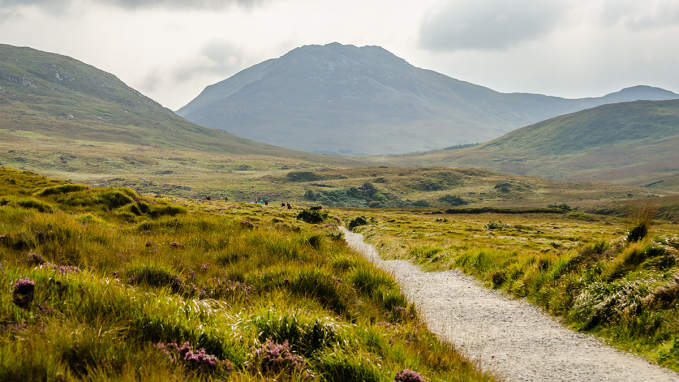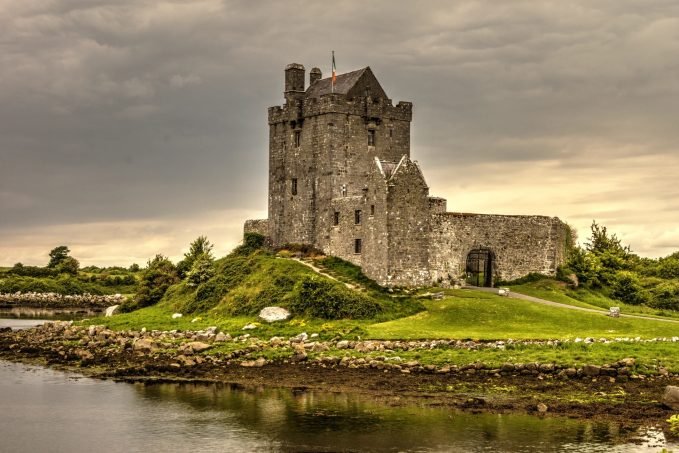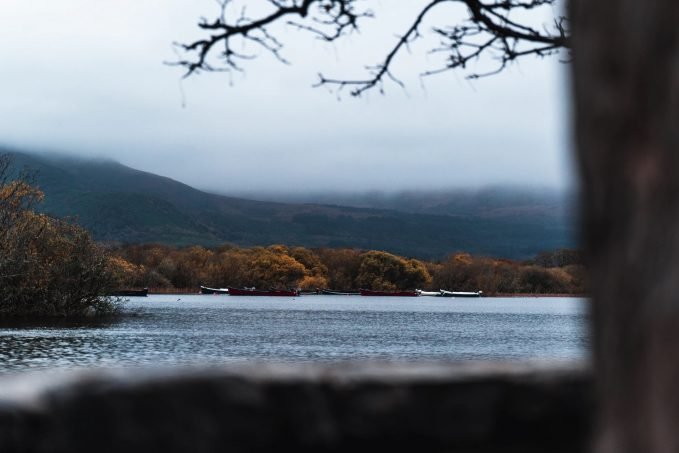The most famous French song about Ireland: “Les Lacs du Connemara” by Michel Sardou

Image credit: “Connemara National Park” by banjipark
You may be a little bit surprised, but yes, there’s a famous French song about Ireland that’s 40 years old this year. Let’s learn more about it.
If you want to see what most French people know about Ireland, you should know that there’s a famous French song that tells a story set in Connemara. If you’re Irish, you may not like everything revealed here because the song was written by French artists, almost randomly, and may not be the most accurate tribute to your country. Anyway, it exists, and it’s both a nice and a surprising song.
When he dropped his single “Les Lacs du Connemara” (The Connemara’s Lakes, if you want a translation), Michel Sardou was already a famous yet controversial French singer. The song wasn’t his most shocking, but it’s still one of his most famous, even with people who are not part of his traditional fanbase.
The origins of the song
The song’s story is so peculiar that it’s worth talking about and several French articles have already written on the topic. To sum up, it was almost written by accident. And it wasn’t supposed to talk about Ireland at all, mostly because Michel Sardou had never been to Ireland and probably didn’t know a lot about the country’s history.
Legend has it that Sardou’s composer, Jacques Revaux, once brought his synthesizer to the singer’s house, but was having problems with the instrument during the journey: when he tried to play it, it sounded like bagpipes. Artists don’t need much to be inspired, and Sardou and his songwriter Pierre Delanoë got an idea: they wanted to write a song with this Celtic sound. In fact, they wanted to write a song about Scotland.
Since neither of them knew anything about Scotland, they started to look for information, but it was the 1980s and the internet didn’t exist yet, so they couldn’t find much. However, what they did find was a tourism brochure about Ireland, which they referred to for places and names. They found “Connemara”. And the rest is history.
An atmosphere created by the music
Have you listened to the song, yes? Let’s first talk about the music itself and the atmosphere it creates. The bagpipes do a lot to set the scene and put you in the right mood. Then there are the variations, little things that make the song special. It’s a very long song (6:02 minutes) but it’s not boring because the rhythm keeps changing.
During the slow parts, you dive into a story that sounds epic or glorious. The voice is strong, you can guess that it is serious. One may argue about this, but music is a lot about mood and atmosphere, and the grave verses of the song work well on that point. You almost want to sing at the top of your lungs with the singer, with a hand on your heart and passion in your voice.
That’s it! Now, you’re a knight. I don’t set the rule, it is what it is.
But then come the quick parts, and here you are in for a run, because if you want to sing with him, you’d better be fast. You leave behind the grave tones for most joyful and lively ones. The voice still sounds serious (because it’s Michel Sardou, if you have heard any other songs you know that he almost always sounds serious) but you can finally dance. You can sing the la-la-la parts too, feeling the rhythm quicken as you speed up too. There is no more to say about the music, except that it is very well done, and keeps you up and interested through the whole song. Now let’s take a look at the lyrics.
A story told by the lyrics
If you’re not a French-speaker and you can’t understand anything he says, don’t worry about it: full translations exist online. But if you’re Irish and you know your country, you probably recognize some names and places, even with Sardou’s French accent.
The picture depicted in the first two verses of the song isn’t the most beautiful one. He talks about burned land (“terre brulée”), a little hell (“un peu d’enfer”) and black clouds (“des nuages noirs”). This is supposed to set the scene for Connemara. The lyrics match the seriousness of the slow music. But when the rhythm speeds up, the lyrics also change to paint a better picture. And here we find, when spring arrives, the main story of the song: an Irish wedding.
Maureen and Sean are the bride and the groom. They are both Catholics, so there is no religious problem with the wedding. They get married in Limerick, which surprisingly enough for French people, isn’t in Connemara (for those who don’t know, Connemara is a region in County Galway and Limerick is a city in County Limerick). Then the party starts.

Tipperary, Ballyconnelly, Galway, the Ring of Kerry… are names Irish people can probably recognise. Connor, O’Connolly, and Flaherty are the Irish-sounding family names. And, of course, to stick with the cliché, the song tells you that they have everything they need to drink for three days and two nights (“et de quoi boire trois jours et deux nuits”). Good party on the way.
Back to a slow part, with more poetic lyrics telling you that people in Connemara know the price of silence (“on sait tout le prix du silence”) and that life is a folly which can be danced away (“on dit que la vie, c’est une folie et que la folie ça se danse”). Not everything makes sense, but that’s often the case in poetry, isn’t it? After a repetition of the first two verses depicting a dark picture, the party comes back with the mention of the Gaels and Cromwell. Well, mentioning Cromwell is not the happiest way to tell Irish history (for those who don’t know, Cromwell was Lord Protector of the Commonwealth of England, Scotland and Ireland between 1653 and 1658 and his “Irish campaign” was very brutal).
The next verse is interesting because it’s the main reason why a lot of French people still think the song’s about Scotland (if they are bad at geography and don’t know where Connemara is):
“On y croit encore aux monstres des lacs qu’on voit nager certains soirs d’été et replonger pour l’éternité” (We still believe in the monsters of the lakes that we see swimming on certain summer evenings and return to the deep, never to be seen again).
Indeed, when you hear about lake monsters, you automatically think about Loch Ness in Scotland. French people don’t know about Muckie, the mysterious creature of the Lakes of Killarney. And Killarney isn’t even in Connemara.

Connemara is described as a place where foreign men (“des hommes d’ailleurs”) come to rest their souls and find a “taste of better” for their hearts (“venus chercher le repos de l’âme et pour le coeur un goût de meilleur”). And then the song comes back to history with very eloquent allusions to the religious divisions on the island and the belief that a peaceful reunion is still possible:
“l’on y croit encore que le jour viendra, il est tout près, où les irlandais feront la paix autour de la croix” (we still believe that the day will come, when the Irish will all make peace around the Cross).
But the song also mentions the price of war and the fact that people won’t accept the peace of Welsh or English kings (“on n’accepte pas la paix des Gallois ni celle des rois d’Angleterre”).
But why is it so famous?
This song is 40 years old this year, but almost all French people have heard it at least once. Why? Probably not because it’s the most broadcasted song ever, because it surely is not. The reason is more surprising: the song is very popular in all kinds of parties, even student parties where most of the people weren’t born when the song was released. And especially in renowned schools like HEC (a very famous French business school), where the song is even played at the end of the graduation ceremony.
[wpdevart_youtube caption=”” align=”left”]HtDdeWxHPio[/wpdevart_youtube]
All that we’ve already said about the music, the variations, the rhythm, and the lively lyrics could be a part of the explanation, but it’s surely not enough, because nobody really knows what makes this song so popular. At wedding parties, it may be because the traditional French uncle is an eternal fan of Michel Sardou. But at student parties?
The French newspaper Le Parisien published an article on its website in 2019 trying to explain this strange phenomenon by asking students why the song was so important to them. For Hugo, former head of the students’ office at the Catholic Law University of Lille, the song has a sort of unifying power for drunk people, who end up jumping to the spot “like a herd of animals”.
By interviewing two DJs, one from the Paris area and one from the south of France, the article also shows us that the song is popular in clubs all over the country and that people even request it, because it has a sort of social aspect: nobody can dance on their own when the song starts. The article points out that the song is also the last way to let off steam during a party before going home, because no song can have the same impact after this one.
In conclusion, it’s very difficult to point to a single reason why this song is so famous, even 40 years after its first release. Unfortunately, we can doubt that the Irish narrative has a part to play, but the Celtic sound is surely one of the reasons for its success.
Now you know about this strangely popular French song about Ireland! Did you know about it before reading this article? Let us know what you think about it in the comment section!
Laurine I enjoyed your article tremendously. Thank you.
Very interesting article!
Addition: the song is well known in Holland and Belgium too.
Thank you for the very good explanation ! ☕️
Having just come home at 3am from yet another birthday party in Saint-Omer where the evening ended with the singing of Les Lacs Du Connemara I decided finally to try to find out about it!
Thank you! Sounds perfectly reasonable … and also very French!
Great party — good singing — and I am Scottish!
It’s accidentally become a new year’s eve classic here in England/Wales with our family and friends.
My friend Rich was sipping whisky from Connemara. I googled Connemara to find out more. We found the song and danced like maniacs; kids and adults in a crazy march. Amazing.
The pipes sounds more like the Uilleann pipes, also known as the Irish pipes.
Having just heard the song for the first time while reading your article. It’s the jauntiness of the faster bits that captivated me. Great to hear Irish beauty spots getting a mention in a continental song
I’m Irish by the way
Thank you for a great explanation! I was really intrigued about the meaning and the popularity of this song, and your article has really helped!
100% right. “Les lacs du connemara” is like “i will survive” in France. it is a song that brings people together.
Will be the song of the Rugby World Cup 2022
I first heard this song about two weeks ago while on holiday in France – it was the grand finale to a karoke evening and it certainly did get everyone up singing and dancing (even if we didn’t have a clue what we were singing about!). Thanks for your article – great to know more about it!
Merci beaucoup pour l’article tres bon.
Je suis au Irlandais
Another thing is that deep down in every French people, unconsciously there is a forgotten longing for her lost celtic sister, the Ireland. It’s like a solidarity with the lost brothers and sisters that are so far away that we will never see again, there are just the stories about them who arrive to us.
A l’Irlande, notre soeur pour toujours!
What a fascinating article! Thank you!